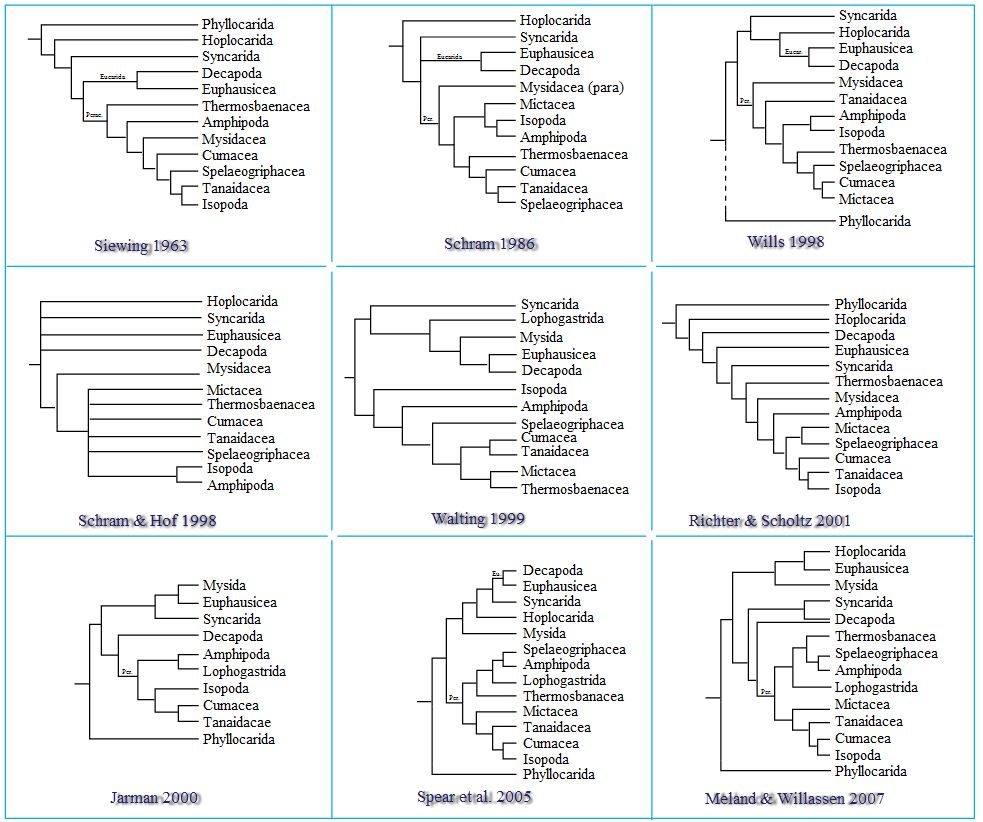Malacostraca
Taxa on This Page
- Malacostraca
The following is copied with minor modifications from William Twenhofel and Robert R. Shrock 1935, Invertebrate Paleontology, McGraw Hill Book Co. New York & London, posted at the Internet Archive as public domain. The content has been lightly edited MAK120518
The Malacostraca comprise a great number of diverse forms, including familiar crustaceans as crabs, crayfish, lobsters, shrimps, etc.
Ecology
The Malacostraca are also the great scavengers of the sea bottom, eating everything of organic character irrespective of the degree of decomposition. Many have a "gastric mill" in the intestinal tract in which shells that have been swallowed are broken into bits or ground into powder. Some of the larger species break open shells with their claws in order to obtain the animals inside. Under favorable conditions all organic matter on certain bottoms passes through the alimentary tracts of some of the Malacostraca and suffers both mechanical and chemical alteration during the passage.
Morphology
Living members of the subclass have 14 or 15 body segments posterior to the head. In addition to the appendages on the head, there are eight pairs of thoracic appendages and six pairs on the abdomen. Paired eyes are generally present and are frequently stalked. The newly born individual has progressed beyond the nauplius stage and is frequently quite similar in appearance to its parents except for size.
Phylogeny
The following is from Wikipedia. To save time, refernces have not been hyperlinked
The class Malacostraca is united by a number of well-defined and documented features, which were recognised a century ago by William Thomas Calman, who in 1904 ,[1] and 1909 described these common morphological features and introduced the major taxonomic subdivisions of the Malacostraca which are still in use today: he divided the Malacostraca in two subclasses the Phyllocarida and the Eumalacostraca, which is further subdivided into four superorders: Eucarida, Peracarida, Hoplocarida and Syncarida.[8]
Calman coined the term caridoid facies for the common eumalacostracan (shrimp-like) features; the most important of these is the constant number of segments in each tagma: members of this class have five segments in the cephalon, eight thoracic segments (thoracomeres) and six segments in the pleon and possess a telson, which forms a characteristic tail fan when the uropods are present. Many other characteristic features are present but their presence varies amongst lineages; one notable ancestral feature which varies is the carapace, which may be absent, reduced or well developed covering the whole cephalothorax. Monophyly has also been confirmed by molecular studies .[7] Furthermore, Richter, S., & Scholtz, G. (2001)[9] list five separate unique eumalacostracan features which taken together form a strong argument in favour of the monophyly of the main subgroup, the Eumalacostraca.
However the phylogenetic relationship (the evolutionary tree) of the orders which compose this class is unclear due to the vast diversity present in their morphology. Molecular studies have attempted to infer the phylogeny of this clade,[2][3][4] resulting in phylogenies which have a limited amount of morphological support,[5] to resolve a well-supported eumalacostracan phylogeny,it will be necessary to look beyond the most commonly utilized sources of data (nuclear ribosomal and mitochondrial sequences) to obtain a robust tree in the future.[6]

Phylogenetic trees from several published studies. The first six were obtained via morphological data whereas the last three were obtained with molecular data using a GTR+G+I model (General time reversible + gamma distribution + independent frequencies). (Adapted from Spear et al., 2005[2][4]).
Image by Squidonius, Wikipedia, Public domain. |
References
To save time, pdfs have not been hyperlinked or formatted, see the Wikipedia page for links
[1] W. T. Calman (1904). "On the classification of the Crustacea Malacostraca". Annals and Magazine of Natural History 7 (13): 144–158.
[2] Simon N. Jarman, Stephen Nicol, Nicholas G. Elliott & Andrew McMinn (2000). "28S rDNA evolution in the Eumalacostraca and the phylogenetic position of krill". Molecular Phylogenetics and Evolution 17 (1): 26–36. doi:10.1006/mpev.2000.0823. PMID 11020302.
[3] Trisha Spears, Ronald W. DeBry, Lawrence G. Abele & Katarzyna Chodyla (2005). "Peracarid monophyly and interordinal phylogeny inferred from nuclear small-subunit ribosomal DNA sequences (Crustacea: Malacostraca: Peracarida)" (PDF). Proceedings of the Biological Society of Washington 118 (1): 117–157. doi:10.2988/0006-324X(2005)118[117:PMAIPI]2.0.CO;2.
[4] K. Meland & E. Willassen (2007). "The disunity of "Mysida" (Crustacea)". Molecular Phylogenetics and Evolution 44 (3): 1083–1104. doi:10.1016/j.ympev.2007.02.009. PMID 17398121.
[5] G. C. B. Poore (2005). "Peracarida: monophyly, relationships and evolutionary" (PDF). Nauplius 13 (1): 1–27.
[6] Ronald A. Jenner, Ciara Ní Dhubhghaill, Matteo P. Ferla & Matthew A. Wills (2009). "Eumalacostracan phylogeny and total evidence: limitations of the usual suspects" (PDF). BMC Evolutionary Biology 9 (1): 21. doi:10.1186/1471-2148-9-21. PMC 2640363. PMID 19173741.
[7] Alexandre Hassanin (2006). "Phylogeny of Arthropoda inferred from mitochondrial sequences: Strategies for limiting the misleading effects of multiple changes in pattern and rates of substitution". Molecular Phylogenetics and Evolution 38 (1): 100–116. doi:10.1016/j.ympev.2005.09.012. PMID 16290034.
[8] R. Brusca & G. Brusca (2003). Invertebrates (2nd ed.). Sunderland, Massachusetts: Sinauer Associates.
[9] Stefan Richter & Gerhard Scholtz (2001). "Phylogenetic analysis of the Malacostraca (Crustacea)". Journal of Zoological Systematics and Evolutionary Research 39 (3): 113–136. doi:10.1046/j.1439-0469.2001.00164.x.
- Wikipedia
Descriptions
Malacostraca
Phylogeny: Phosphatocopida + (Branchiopoda + Remipedia + (Maxillopoda + Ostracoda + * : Phyllocarida + (Hoplocarida + Eumalacostraca))
Characters: typically fourteen (rarely fifteen) body somites besides the telson. All the somites (except the fifteenth) bear appendages which are differentiated into two groups, a thoracic of eight and an abdominal of six pairs. - Zittel & Eastman 1913

